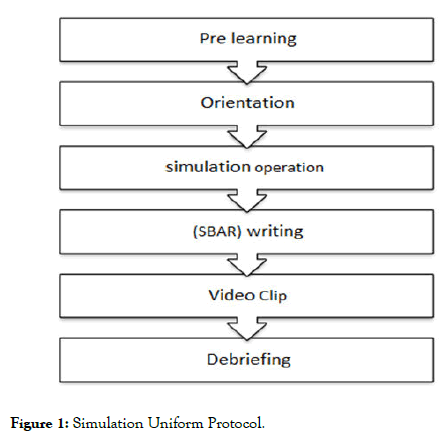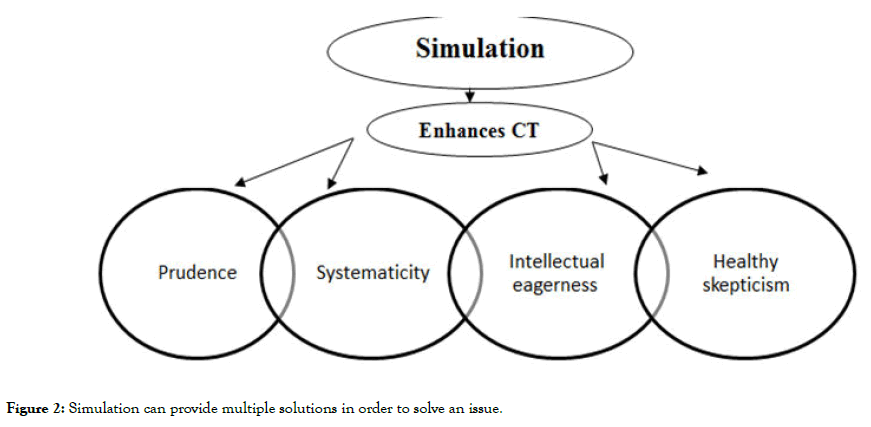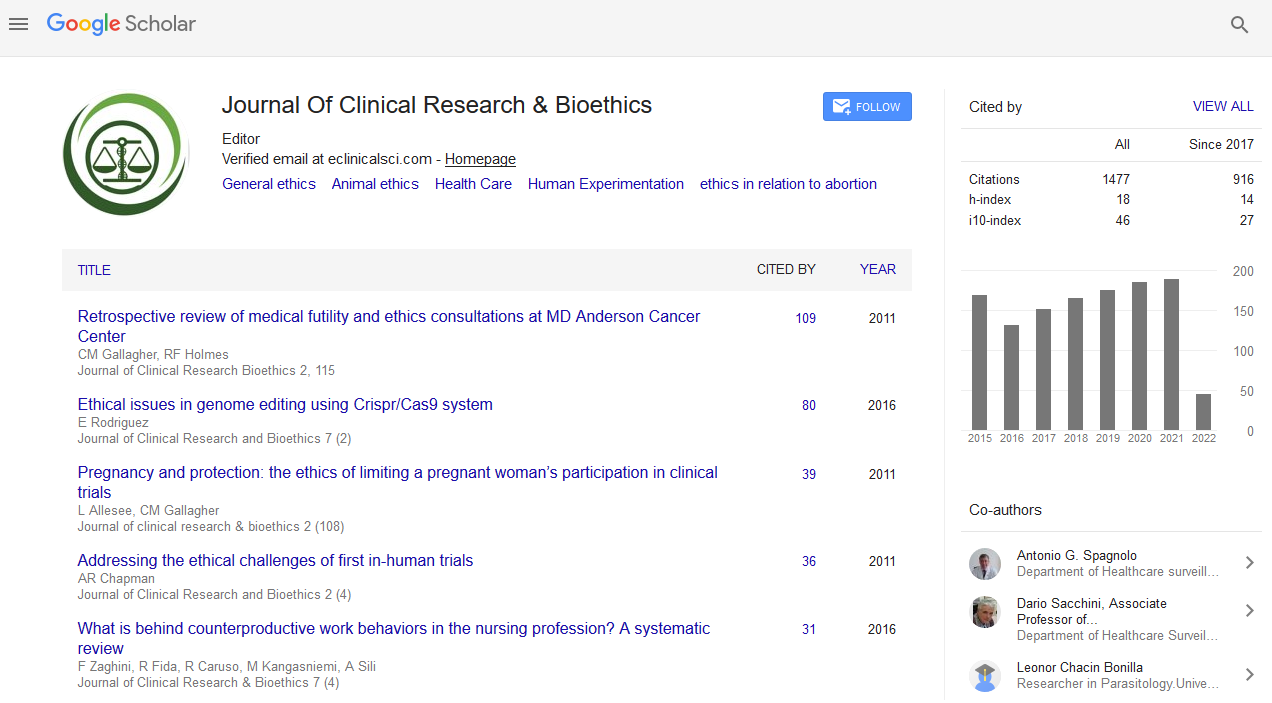PMC/PubMed Indexed Articles
Indexed In
- Open J Gate
- Genamics JournalSeek
- JournalTOCs
- RefSeek
- Hamdard University
- EBSCO A-Z
- OCLC- WorldCat
- Publons
- Geneva Foundation for Medical Education and Research
- Google Scholar
Useful Links
Share This Page
Journal Flyer

Open Access Journals
- Agri and Aquaculture
- Biochemistry
- Bioinformatics & Systems Biology
- Business & Management
- Chemistry
- Clinical Sciences
- Engineering
- Food & Nutrition
- General Science
- Genetics & Molecular Biology
- Immunology & Microbiology
- Medical Sciences
- Neuroscience & Psychology
- Nursing & Health Care
- Pharmaceutical Sciences
Review Article - (2019) Volume 10, Issue 4
Effectiveness of Simulation for Students' Critical Thinking and Financial Constraints in Developing Countries
Anila Naz Ali Sher*, Tanseer Ahmed and Akhtar AliReceived: 16-Nov-2019 Published: 02-Dec-2019
Abstract
This review paper is aimed at discussing the characteristics of simulation as teaching strategy as well as an assessment tool and its usability to enhance critical thinking among nursing students. “Simulation is a "technique" not a technology that focuses on creating real-life situations to allow students to practice or gain skills in a safe environment”. Likewise, critical thinking is a skillful application of knowledge for judgment and evaluation of complex issues or problems. “The effect of simulation courseware on critical thinking in undergraduate nursing students: Multi-site pre-post study” by has chosen to create a platform for discussion.
The purpose of this study was to evaluate the effect of an integrated pediatric nursing simulation used in a practicum on students’ critical thinking and to identify the effects of number of simulation exposures on critical thinking in a multisite environment in three different nursing schools.
The objective of the study was to explore and examined the effects of exposures of simulation coursework on critical thinking of nursing students.
Keywords
Simulation; Healthy Skepticism; Intellectual eagerness, Prudence
Introduction and Background
A convenience sample (n=237) of undergraduate senior nursing students were recruited from three universities in Korea. Simulation courseware had three major scenarios:
1. Rapport building
2. Emergency measures for a high risk newborn with apnea
3. Febrile infant care
Simulation time for each scenario, including the operation, self-analysis and debriefing was about one hour. High fidelity simulators along with standardized patients were being used for simulation sessions model for clinical judgment was used to enhance clinical judgment skills of the students, which also provide areas for feedback and coaching of students to develop their own critical thinking [4]. The scenario required the students to use their CT to prioritize care in a specific situation. Each session had followed the uniform protocol (Figure 1):

Figure 1: Simulation Uniform Protocol.
Here (SBAR) is situation, background, assessment and recommendation. And video clip is for student performance for self-evaluation. Learning outcomes were evaluated by using Critical Thinking Disposition Tool (CTDT) by [5] and simulation effectiveness tool [6].
The results from paired t-test showed that the overall CT score significantly increased. The gain in students CT score varied according to the number of exposures to simulation courseware. As well as there is a significant increase in 4 of 7 sub categories of critical thinking (prudence, systemiticity, healthy skepticism and intellectual eagerness). Prudence showed a significant increase in all three schools.
This has been observed that there is very poor coordination between nursing education and Critical thinking. And there is very little research work on simulation exposure to enhance CT among nursing students. The most important finding of this study is basically the CT score of students which was significantly enhanced by use of simulation strategies. And so forth the findings of this study indicated that simulation can help nursing students to think more critically in terms of prudence, systematicity, intellectual eagerness and healthy skepticism. This also corresponds to enhanced maturity of judgment. A person with Maturity of judgment can see multiple solutions in order to solve an issue (Figure 2).

Figure 2: Simulation can provide multiple solutions in order to solve an issue.
Reflection on Contemporary Issues of Developing Countries
Critical thinking and decision making skills are a crucial element of the nurse's role; simulation actively encourages and develops these vital skills in nursing students in a safe environment [6,7]. It gives a greater opportunity to practice without any fear of harm to patient or learner found in a systematic review that simulation ameliorate critical thinking skills, knowledge acquisition, and the aptitude to recognize a worsening disease process in patient [8].Therefore, Simulation is having a significant impact on learning as well as development of critical thinking skills in under graduate and post graduate students not only from nursing but across all disciplines of health care education.
Simulation enables to get highest acquisition of skills through hands on practices. It has made easier for educators to teach different skills like history taking, physical examination and management of acute emergencies in an easier way. This is a student centered approach to make them respond higher order thinking questions followed by general curiosity. It also enables educators to evaluate their students' soft skills as well as reflexes during emergent situations. Therefore, Simulation not only serves as teaching strategy but it is equally effective as a formative and summative assessment tool. It may serve as an optimal method to create authentic assessments for nursing education because they are grounded in an authentic task and can be used to both teach and assess learning, which involves all three domains of teaching and learning: cognitive, affective and psychomotor performances [9].
According to the present literature simulation is growing rapidly across the world. The evidence suggests that the simulation environment actively encourages learning, decision making skills and confidence, and assessment skills [7,10]. However, there are very little robust research studies found as evidence in terms of Simulations' effects on students' critical thinking.
The positive benefits of simulation as an educational tool allow nurses to interact and they can immerse themselves in a clinical scenario without causing harm to the patient. By repeatedly practicing the skills nurses become able to learn better from their mistakes [5]. Furthermore, the simulated environment enables them to reflect on their own skills and practices and this further promotes learning as well as reciprocal interaction in terms of nurses' clinical interventions and patient outcomes. As well as another positive feature of simulation is debrief, which is considered a way to bridge theory with practice, it play a crucial role in learning of clinical judgment and it facilitates students to relate theory to practical clinical applications [11,12].
Due to financial constraints simulation has not yet implemented in many health care setting in Pakistan. Irrespective of type of simulation (low, mid and high fidelity), more focus should be on the outcomes of simulation, which will also cater the educational needs of learner for example use of Standardized Patients (SPs) or task trainer simulators, which fosters students transformative learning through hypothetical planning to apply simulated experiences in actual clinical setting.
Conclusion
Health care simulation has largely been implemented in past 15 years in European countries with the support of funding agencies. In our context, where patient care is multi-faceted task must requires multi-faceted approaches to deal with certain issues. We really need to integrate simulation labs for the graduate and under graduate nursing students in order to make them competent nurses. For this purpose, there is a need to involve funding agencies to support these kinds of programs in Pakistan to achieve excellence in health care setting. As well as, there is a scant of researches on "how to make it more effective?" So, we need to emphasize more and more on the research studies, not to check the effectiveness of simulation but to investigate the fact that how CT and clinical judgment enhancement take place by use of simulation as a teaching strategy for nursing students in different contexts.
REFERENCES
- Gaba DM. A brief history of mannequin-based simulation & application. Simulators in critical care and beyond. 2004; 7-14.
- Jones SA, Brown LN. Alternative views on defining critical thinking through the nursing process. Holist Nurs Pract. 1993; 7(3):71-76.
- Shin H, Ma H, Park J, Ji ES, Kim DH. The effect of simulation courseware on critical thinking in undergraduate nursing students: Multi-site pre-post study. Nurse Educ Today. 2015;35(4):537-542.
- Tanner CA. Teaching clinical judgment. Annu Rev Nurs Res. 1987;5:153-173
- Bradley P. The history of simulation in medical education and possible future directions. Med Educ. 2006;40(3):254-262.
- Bliss M, Aitken LM. Does simulation enhance nurses' ability to assess deteriorating patients? Nurse Educ Pract. 2018;28:20-26.
- Disher J, Burgum A, Desai A, Fallon C, Hart PL. The effect of unit-based simulation on nurses’ identification of deteriorating patients. J Nurses Prof Dev. 2014;30(1):21-28.
- Lapkin S, Levett-Jones T, Bellchambers H, Fernandez R. Effectiveness of patient simulation manikins in teaching clinical reasoning skills to undergraduate nursing students: A systematic review. JBI Libr Syst Rev. 2010;8(16):661-694.
- Jeffries PR. Simulation in nursing education: From conceptualization to evaluation. New York: National League for Nurses. 2007.
- Henriksen K, Rodrick D, Grace EN, Brady PJ. Challenges in Health Care Simulation: Are We Learning Anything New? Acad Med. 2017; 93(5):705-708.
- Abelsson A, Bisholt B. Nurse students learning acute care by simulation–Focus on observation and debriefing. Nurse Educ Pract. 2017;24:6-13.
- Mariani B, Cantrell MA, Meakim C, Prieto P, Dreifuerst KT. Structured debriefing and students' clinical judgment abilities in simulation. Clinical Simulation in Nursing. 2013; 9(5):147-155.
Citation: Sher AN A , Ahmed T, Ali A (20 1 9) Ef f ectiv eness of Simulation f or S tudents' Critical Thinking and f inancial cons tr aints in developing countries. J Clin Res Bioeth. 10:339. doi: 10.35248/2155-9627.19.10.339
Copyright: © 2019 Sher ANA, et al. This is an open-access article distributed under the terms of the Creative Commons Attribution License, Which permits unrestricted use, distribution, and reproduction in any medium,provided the original author and source are credited.


